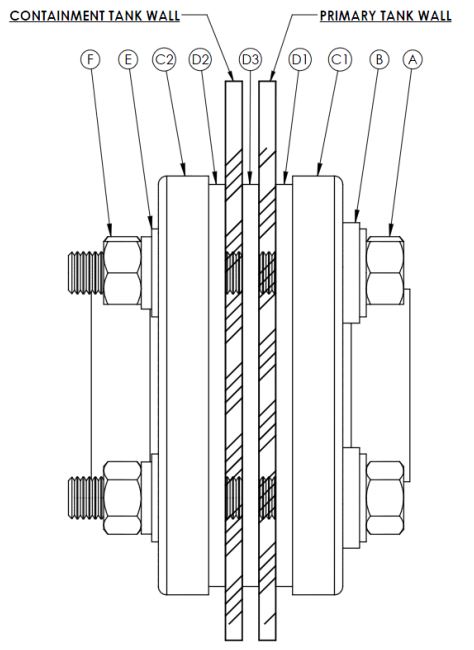Note: The following installation instructions assume the tank has been predrilled and prepared for fitting installation by the factory. Most fittings are factory installed, but check fittings for damage and gasket compression. See section 5.3 for general tank fitting information if a fitting is to be installed without a factory prepared location. Prior to installing fittings, check the sealing surface for debris and/or scratches which could cause leakage.
Threaded Bulkhead Fitting
Remove the nut (C) from the fitting body (A) and gasket (B). See Figure 6.1 for part identification.
Working from inside the tank, slide the fitting body (A) through the hole in the tank. The gasket (B) should be between the fitting body flange and the inside tank wall. Install the nut (C) on the fitting threads protruding on the outside of the tank.
To obtain proper gasket compression for bulkhead fitting installation, tighten the fitting nut hand tight (check to see if it engages the tank wall). Tighten the nut an additional 3/4 turn for fittings less than 1 in., or 1/3 turn for fittings 1 in. or larger. Anti-seize is recommended to prevent thread seizing on bulkhead fittings. Inspect the gasket to make sure it is fully contacting the inner surface of the fitting body flange and the inside tank wall. Gasket compression should be between 25 – 50%. Recheck fitting tightness periodically.
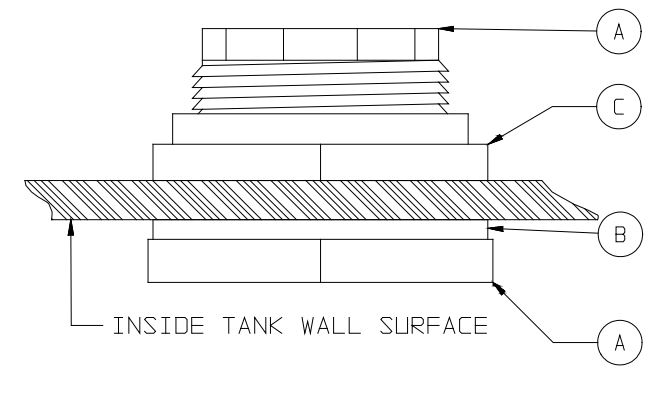
Self-Aligning Threaded Bulkhead Fitting
Follow the same procedures as detailed under threaded bulkhead fitting installation steps 6.1.1 – 6.1.3.
Piping should be installed into the fitting ball with an appropriate thread sealant (i.e. Teflon pipe sealant). Adjust the piping to the required angle (within the limits of the fitting). When the piping has been located as required, tighten the PVC ball retainer ring located on top of the PVC ball.
Bolted Flange Fitting
The bolted flange fitting shall be constructed with 2 ea. 150 lb. flanges (C1 and C2), 2 ea. 150 lb. flange gaskets (D1 and D2), the correct number of full threaded bolts (A), bolt gaskets (B), flat washers (E), lock washers (F), and hex nuts (G) for the flange specified. Note: If the tank wall thickness is greater than or equal to 0.75″, fittings with stainless steel bolts will require longer bolts for installation. Consult with the factory for the correct part number when ordering long bolted flange fittings. Refer to Figure 6.2 for part identification.
Disassemble the fitting as shipped by removing the bolt’s hex nuts, lock washers, flat washers, outer flange, and outer flange gasket. Locate the fitting hole on the inside of the tank and insert the bolts (still installed on the inner flange and gasket) through the drilled holes in the tank. Place the outer flange gasket over the bolts on the outside surface to the tank. Place the outer flange over the outer gasket and bolts. Install the flat washers, lock washers, and hex nuts on the bolts. Check to make sure the fitting assembly appears as shown in Figure 6.2.
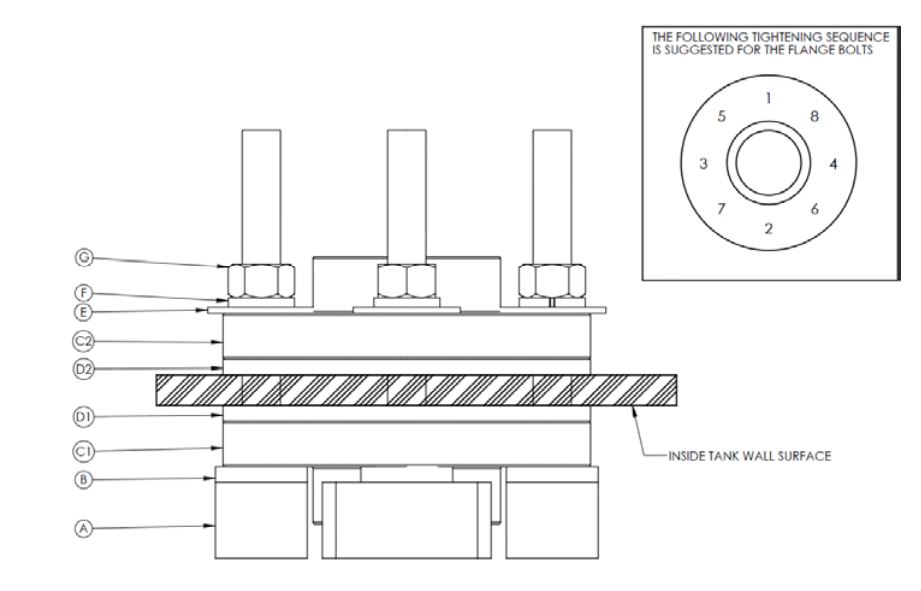
To obtain proper gasket compression, tighten all the fitting nuts hand tight with a deep socket using the bolt tightening sequence shown until the gaskets engage the tank wall and the lock washers are compressed. Tighten each nut an additional 3 turns (2 turns if the inner flange and gasket are not utilized) using the same sequence (do not tighten more than 1 turn at a time). A light application of lubricating oil is necessary to prevent thread seizing on S.S. bolts. Gasket compression should be between 25 – 50%. While gasket compression needs to be the controlling factor to obtain a proper seal, do not apply more torque than recommended by the flange manufacturer. See torque value listed on flange. Recheck fitting tightness periodically.
Bolted Stainless Steel Fitting
The bolted stainless steel fitting shall be constructed with 1 ea. inside flange with studs (A), 1 ea. fitting gaskets (B), 1 ea. outside flange (C), and the correct number of lock washers (D), and hex nuts (E) for the fitting specified. Refer to Figure 6.4 for part identification.
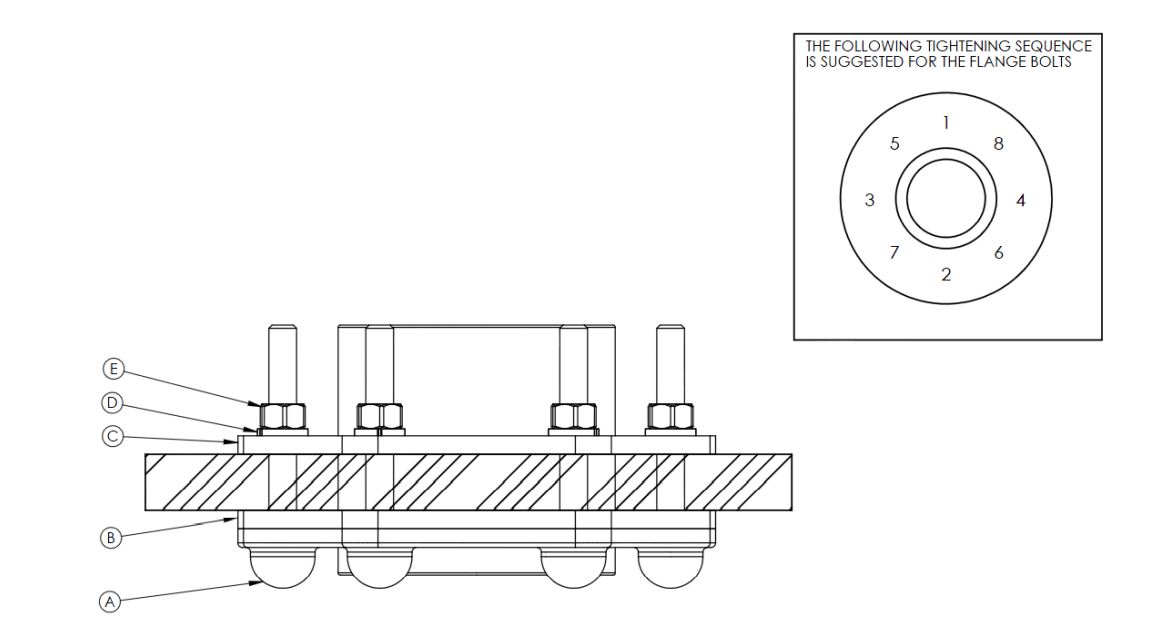
eveDisassemble the fitting as shipped by removing the hex nuts, lock washers, and outside flange. Locate the fitting hole on the inside of the tank and insert the fitting’s studs through the drilled holes in the tank. The flange gasket (B) should be between the inside fitting flange and the inside tank wall. Place the outside flange over the studs on the outside surface of the tank. Install the lock washers and hex nuts on the studs. Check to make sure the fitting assembly appears as shown in Figure 6.4.
To obtain proper gasket compression, tighten all the fitting nuts hand tight with a deep socket using the bolt tightening sequence shown until the gasket engages the tank wall and the lock washers are compressed. Tighten each nut an additional 1 – 2 turns using the same sequence (do not tighten more than 1 turn at a time). Do not apply more than 15 ft. – lbs. of torque. A light application of lubricating oil is necessary to prevent thread seizing on S.S. bolts.
Snyder Unitized Molded Outlet
(SUMO™) (PATENT NO. 5,374,026)
The SUMO fitting shall be constructed with 1 ea. smaller o-ring (A), 1 ea. larger o-ring (B), and 1 ea. SUMO adapter (C). Refer to Figure 6.5 for part identification. Note – The tank is shipped with a shipping stabilizer installed in the SUMO outlet. Never move the container without the shipping stabilizer installed.
Once the tank has been properly placed on its foundation, remove the shipping stabilizer and clean away any dirt or debris from the SUMO outlet threads and o-ring seats. Use only a soft moist cloth. Never use a tool that could scratch the O-ring seats.
Install the smaller o-ring inside the SUMO molded-in fitting. Make sure it is placed in the o-ring seat area evenly. Carefully stretch the larger o-ring enough to install it on the SUMO adapter. Only a SIi SUMO adapter may be used. Use of a non-approved adapter may damage your tank outlet and will void the tank warranty. Theo-ring may be lubricated with a suitable lubricant such as water. Do not use silicone or Teflon sealants. Screw the adapter in until the step on the adapter is flush with the tank wall. Do not over-torque the adapter (25 ft. – lbs. of torque maximum). Figure 6.5 shows a sectional view of an assembled SUMO fitting. 6.5.4 Once the SUMO adapter is installed, other components may be attached to the adapter. A union or flange adapter with a flexible expansion joint should be installed as close to the tank as possible to allow for future disassembly. The SUMO fitting must have adequate clearance for any piping accessories and allow for a ±5° outlet angle change. Consult factory for pad and/or accessory clearance questions. A notch in the tank support pad may be necessary (see Figure 5.2).
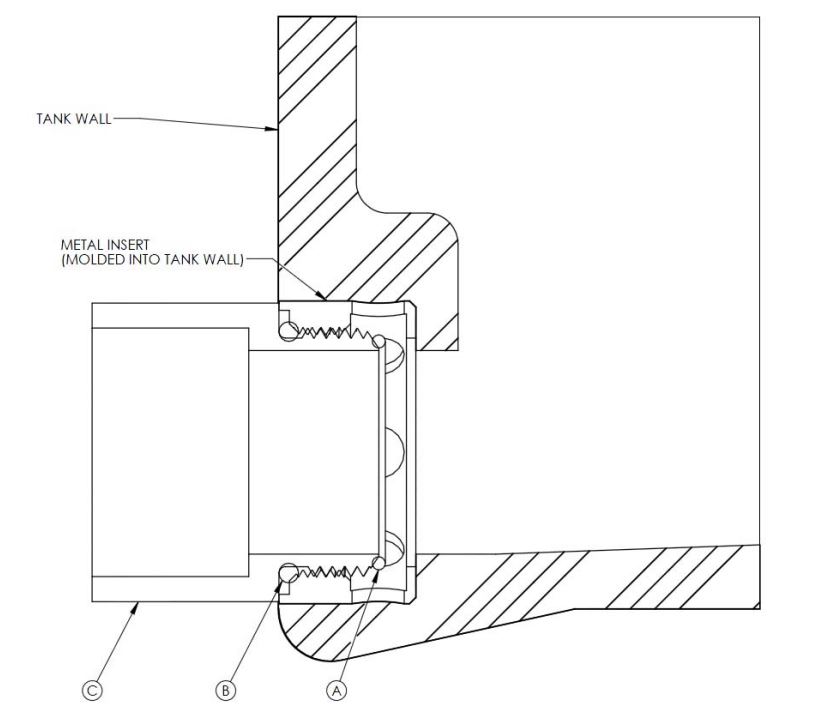
Siphon Tube Fittings
Siphon tubes may be added to the fittings specified in sections 6.1, 6.3, 6.4, and 6.5. Siphon tubes shall be customer installed with the tank in a vertical position after fitting installation.
PVC and CPVC siphon tubes need to be solvent welded with the proper solvent cement into the socket of a previously installed fitting. Threaded siphon tubes need to be threaded in place with Teflon pipe sealant applied to the threads prior to the fitting being installed.
Siphon tubes should be located with the cut notch corner in close proximity of the floor of the tank for maximum drainage, and the siphon tube tilted to the side of the fitting. Refer to Figure 6.6 for proper placement of the siphon tube in the tank.
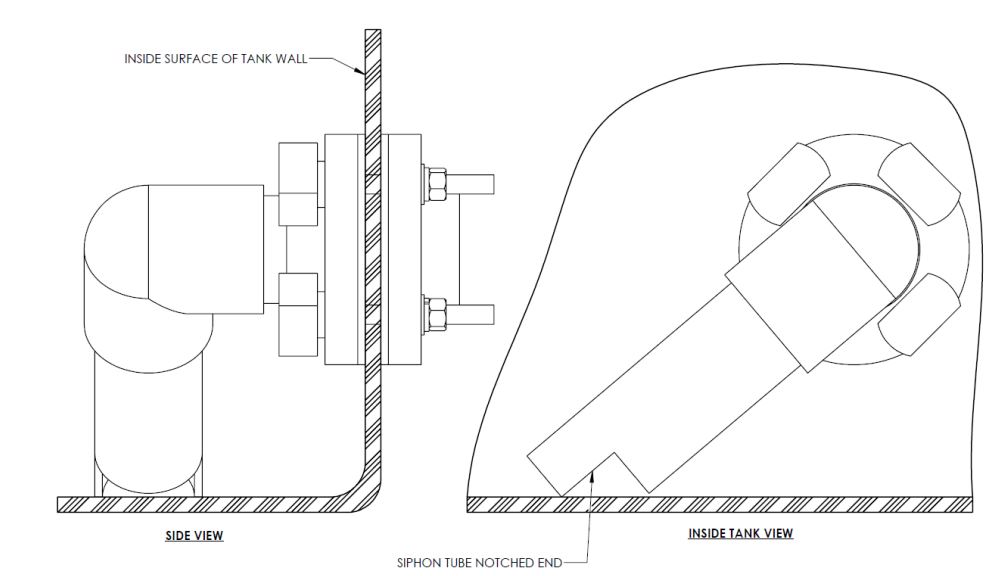
Dual Containment Tank (DCT)
Dual containment tanks can have a sidewall fitting located at the o·, 90°, 180° or 270° locations with a gasket installed in the interstitial space between the primary and containment tank. This option is normally factory installed for use with DCT tank assemblies. This option can be field installed. Consult factory for more details. The bolted fittings used with this option follow the same sealing/tightening criteria as detailed in sections 6.3 and 6.4. An example of this option is shown in Figure 6.8.
The bolted flange fitting shall be constructed with 2 ea. 150 lb. flanges (C1 and C2), 3 ea. 150 lb. flange gaskets (D1 , D2, and D3), the correct number of full threaded bolts (A), bolt gaskets (B), flat washers (E), and hex nuts (F) for the flange specified. NOTE: If the sum of the containment and primary tank wall thicknesses and the interstitial gasket (D3) thickness is greater than or equal to 0.75″, fittings with stainless steel bolts will require longer bolts for installation. Consult with the factory for the correct part number when ordering long-bolted flange fittings. Refer to Figure 6.8 for part identification.
